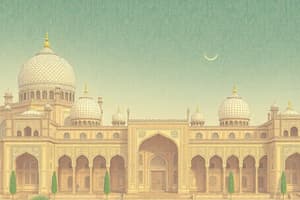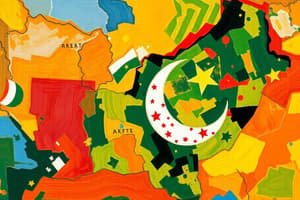Podcast
Questions and Answers
What geographical challenge did Pakistan face immediately after its creation?
What geographical challenge did Pakistan face immediately after its creation?
- Having two non-contiguous parts separated by Indian territory. (correct)
- A lack of natural resources within its territories.
- The absence of any major cities to serve as capitals.
- Having a border dispute with China.
Why was it difficult for West Pakistan to control East Pakistan?
Why was it difficult for West Pakistan to control East Pakistan?
- The two parts were separated by approximately 1000 miles of Indian territory. (correct)
- West Pakistan was only recently formed and lacked the political infrastructure.
- East Pakistan’s population was largely hostile towards West Pakistani.
- East Pakistan had a larger and better equipped military than West Pakistan.
What was a primary challenge Pakistan faced regarding the formation of its government?
What was a primary challenge Pakistan faced regarding the formation of its government?
- The presence of too many political parties that opposed the formation of government.
- The imposition of a British controlled government after independence.
- The immediate threat of military invasion from India.
- A lack of experienced personnel well-versed in political and administrative matters. (correct)
How did Jinnah address the shortage of skilled personnel in Pakistan’s newly formed government?
How did Jinnah address the shortage of skilled personnel in Pakistan’s newly formed government?
Which of these was a challenge faced by Pakistan when dividing the armed forces assets?
Which of these was a challenge faced by Pakistan when dividing the armed forces assets?
What was the condition of the military equipment that Pakistan received after the division?
What was the condition of the military equipment that Pakistan received after the division?
Despite a requirement for 4,000 officers how many officers did Pakistan initially have?
Despite a requirement for 4,000 officers how many officers did Pakistan initially have?
How did Jinnah address the immediate shortage of officers in the Pakistani army?
How did Jinnah address the immediate shortage of officers in the Pakistani army?
What was a primary reason for Pakistan's military weakness following the division of assets?
What was a primary reason for Pakistan's military weakness following the division of assets?
How did the distribution of army officers affect Pakistan's military?
How did the distribution of army officers affect Pakistan's military?
What was the initial agreed-upon share of the cash balance that Pakistan was to receive?
What was the initial agreed-upon share of the cash balance that Pakistan was to receive?
What was the main reason for India's delay in transferring the remaining cash balance to Pakistan?
What was the main reason for India's delay in transferring the remaining cash balance to Pakistan?
What action did Gandhi take to persuade India to pay the due money to Pakistan?
What action did Gandhi take to persuade India to pay the due money to Pakistan?
Why did Field Marshal Auchinleck resign before fully completing the division of armed forces?
Why did Field Marshal Auchinleck resign before fully completing the division of armed forces?
According to the content, how did India's military resources compare to Pakistan's during the partition?
According to the content, how did India's military resources compare to Pakistan's during the partition?
Flashcards
Geographic Challenges of Pakistan
Geographic Challenges of Pakistan
Pakistan was divided into two geographically separate parts: East Pakistan (present-day Bangladesh) and West Pakistan, separated by over 1,000 miles of Indian territory.
Starting from Scratch: Pakistan's Government
Starting from Scratch: Pakistan's Government
The newly formed Pakistani government had to develop its own administrative system from scratch, lacking the experience and skilled personnel that India inherited.
Brain Drain: Skilled Labor Loss
Brain Drain: Skilled Labor Loss
After Partition, many skilled professionals and administrators chose to stay in India, leaving Pakistan with a significant shortage.
Jinnah's Solutions for Government Efficiency
Jinnah's Solutions for Government Efficiency
Signup and view all the flashcards
Dividing Military Assets
Dividing Military Assets
Signup and view all the flashcards
Pakistan's Limited Military Assets
Pakistan's Limited Military Assets
Signup and view all the flashcards
Field Marshal Auchinleck's Role
Field Marshal Auchinleck's Role
Signup and view all the flashcards
Officer Shortage
Officer Shortage
Signup and view all the flashcards
Unequal Division of Military Assets
Unequal Division of Military Assets
Signup and view all the flashcards
Large Army Stores in India
Large Army Stores in India
Signup and view all the flashcards
Withheld Financial Assets
Withheld Financial Assets
Signup and view all the flashcards
Shortage of Military Officers in Pakistan
Shortage of Military Officers in Pakistan
Signup and view all the flashcards
Resignation of Field Marshal Auchinleck
Resignation of Field Marshal Auchinleck
Signup and view all the flashcards
Kashmir Conflict and Financial Pressure
Kashmir Conflict and Financial Pressure
Signup and view all the flashcards
Gandhi's Hunger Strike and Financial Release
Gandhi's Hunger Strike and Financial Release
Signup and view all the flashcards
Study Notes
Geographical Challenges of Pakistan
- Pakistan was divided into East Pakistan (Bengal & Sylhet) and West Pakistan (Sindh, Punjab, Baluchistan, and NWFP).
- Princely states like Swat, Chitral, Dir, Amb, Hunza, Gilgit, and Bhawalpur also joined Pakistan.
- The two parts were geographically distant (nearly 1000 miles apart) with India in between.
- This separation made controlling East Pakistan from the capital in Karachi very difficult.
- There were significant cultural and regional differences between the eastern and western parts beyond religious similarity.
Formation of Pakistani Government
- Pakistan had to establish a government from the ground up, unlike India, which inherited existing structures.
- India's government had experienced administrators, while Pakistan's Constituent Assembly included primarily landlords unfamiliar with administration.
- India retained many skilled individuals after partition, hindering Pakistan's early development.
- To address this, Jinnah arranged special transport to bring skilled individuals from India to Pakistan.
- An agreement with Tata Air of India assisted in this transfer.
- Government offices were temporarily housed in private buildings.
- Jinnah became Governor-General and Liaquat Ali Khan became Prime Minister.
Division of Armed Forces and Assets
- British Field Marshal Auchinleck initially advocated for unified Indian armed forces.
- Despite this, the armed forces and assets were divided based on a 36% (Pakistan) and 64% (India) arrangement.
- Pakistan received significantly fewer military factories and equipment than India.
- The Muslim Regiment was transferred to Pakistan, the Hindu Regiment to India.
- Pakistan's army had 150,000 men but lacked sufficient officers (only 2,500 Pakistani officers).
- Jinnah temporarily recruited 500 British officers.
- The equipment provided was often damaged or obsolete.
- Pakistan received 60 million rupees and established an ordinance factory in Wah Cantt.
- Pakistan's military training programs were expedited, reducing the timeframe needed to train officers.
- The delayed and inadequate delivery of military assets negatively affected Pakistan's defense capabilities.
- Pakistan received a smaller share of armed forces (6 armor, 8 artillery, 8 infantry divisions) compared to India (14 armor, 40 artillery, 21 infantry divisions).
Challenges Related to Division of Armed Forces
- A significant shortage of Muslim army officers existed, given the smaller size of the Muslim officer corps within the British army compared to the Hindu officer corps.
- India retained extensive military stores and supplies that were critical to an effective army.
- The military equipment provided to Pakistan was often in poor condition (obsolete, damaged, unusable).
- Field Marshal Auchinleck's early resignation further complicated the transfer process, hindering Pakistan's capability.
Financial Issues After Partition
- A significant amount of cash (4 billion rupees) was held in the Reserve Bank of India.
- Pakistan was allocated 750 million rupees.
- The first installment of 200 million rupees was received, but the remainder was withheld due to the Kashmir dispute.
- India delayed the remaining funds due to the ongoing conflict in Kashmir.
- India suspected that Pakistan would use the funds for weapons to be used against India.
- India essentially wanted to bankrupt Pakistan by withholding the remaining financial aid.
- Gandhi intervened, threatening a hunger strike to ensure a fair financial settlement with India.
- 500 million rupees were eventually freed due to Gandhi’s pressure.
Studying That Suits You
Use AI to generate personalized quizzes and flashcards to suit your learning preferences.




